Is AI in UX research a groundbreaking innovation or just a fleeting trend?
In this fast-changing time, AI is not just an instrument to aid in research but also a transformative powerhouse for UX research. This guide for 2024 delves into the growing impact of AI, and reveals how it automates, analyses, and improves our understanding of the behavior of users.
The role of AI is explored in the reshaping of UX research and highlights the ability of AI to draw exact insights from user data at a staggering rate. Take part in our discussion as we delve through the intricate details and potential for AI to improve UX research in which technology is paired with human-centric design.

The Ultimate Guide for UX Designers
The only ebook you'll ever need to master AI for UX design.
Get 30% Off Today7 Ways AI is Revolutionizing UX Research
The incorporation of Artificial Intelligence (AI) in User Experience (UX) research represents a radical change across a variety of industries. This shift is apparent in UX research in which AI is altering traditional methods and workflows. Here are seven ways that AI can contribute to these advancements:
Automatic Data Analysis: AI tools can process and analyze huge amounts of data faster than human beings. This technology allows for faster extracting meaningful patterns as well as insights, trends, and patterns from research data of users which significantly speeds the process of research.
Enhanced User Testing: AI-powered tools for user testing perform usability tests, eye-tracking studies, and sentiment analysis autonomously. Automation results in an increase in efficiency and the scale of user testing, allowing UX researchers to collect feedback from customers faster and of greater size.
Personalized User Experiences: AI's ability to analyze the patterns and data of its users creates highly customized user experiences. This can be achieved through the customization of interfaces and suggestions according to user preferences which results in more enjoyable and meaningful experiences.
Streamlined Participant recruitment: AI-driven platforms like UserZoom simplify the process of recruiting to support UX research. This technology helps to find various participants worldwide, making it easier and less time-consuming, while also reducing difficulties in logistics frequently associated with manual recruiting processes.
Predictive Insights and Trend Analyses: AI techniques used for UX research can help predict the behavior of users and forecast future trends using past data. This predictive capability allows UX researchers to anticipate the needs and preferences of users which can lead to more strategic and proactive design choices.
Predictive User Experience Modeling: AI algorithmic models are currently being designed to predict the future of user behavior and preferences using past and current data as well as patterns of interaction. This type of predictive modeling allows UX researchers to anticipate future user requirements and design challenges before they occur, which allows for innovative design solutions.
Emotional Analysis and Sentiment Mapping: AI technology, specifically ones that specialize in natural computer vision and language processing uses AI to study emotional reactions and feelings of users. This goes beyond the traditional usability tests to determine the impact on emotions of the design.

AI-Powered Tools Transforming UX Research
1. UX Pilot by Adam Fard Studio:
This magical tool by Adam Fard Studio is a UX Designer’s best ally. It harnesses AI for in-depth design reviews, pinpointing areas needing enhancement and suggesting improvements, seamlessly integrating with design platforms like Figma for real-time insights.
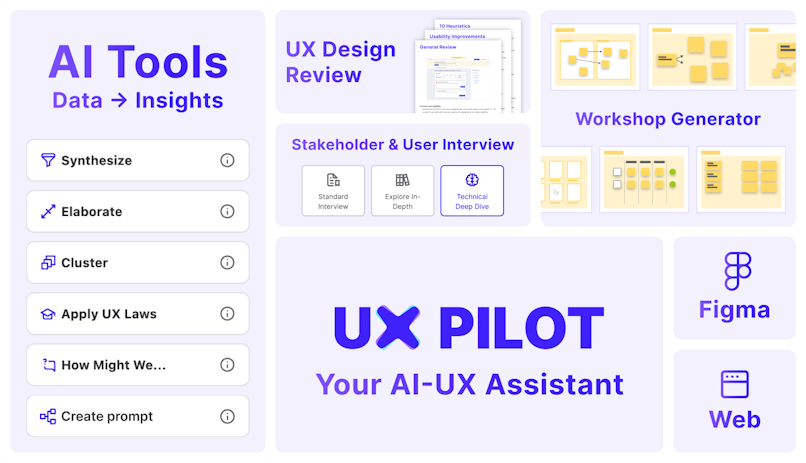
Functionality: UX Pilot leverages artificial intelligence to conduct comprehensive design reviews. It scrutinizes user interfaces, identifies areas needing improvement, and suggests design enhancements. Its advanced AI algorithms ensure that user interfaces are intuitive and user-friendly.
Integration: Seamlessly integrating with popular design tools like Figma, and UXPilot brings the power of AI directly into the design process. This integration allows for real-time collaboration, instant insights, and the ability to brainstorm and refine ideas within the design environment.
Custom Workshops: Apart from AI-driven reviews, UX Pilot also offers custom workshops tailored to specific design challenges. These workshops, guided by AI insights, facilitate collaboration, idea generation, and problem-solving among design teams.
Project Requirements Gathering: The tool assists in gathering and analyzing project requirements, and aligning designs with the goals and needs of the product or service.
Use Case Study: A burgeoning fintech company adopted UX Pilot to overhaul its user interface. The AI-driven feedback identified subtle navigational issues and suggested intuitive design elements. Post-implementation, the app saw a 30% uptick in user retention and a notable reduction in customer service inquiries, demonstrating the tool's impact on user experience and operational efficiency.
2. Uizard:
Uizard excels in transforming rudimentary sketches into interactive prototypes using AI, significantly reducing design time.
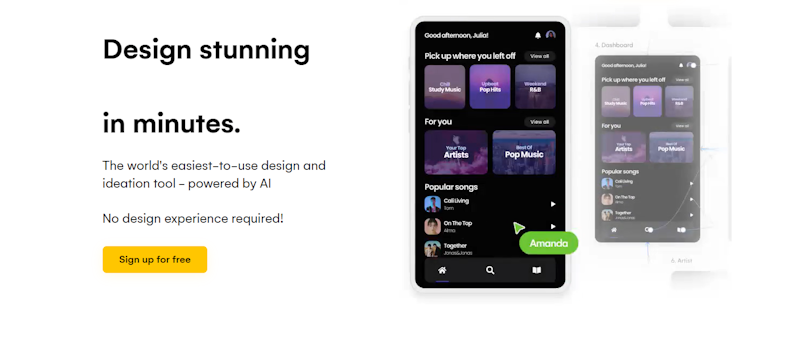
Rapid Prototyping: Uizard's core strength lies in its ability to convert sketches and basic design concepts into interactive prototypes using AI. This capability is handy for quickly visualizing and iterating design ideas.
AI Design Tool: It acts as a comprehensive design assistant, leveraging AI to generate design elements, layouts, and even entire user interfaces based on textual or sketch inputs.
Collaboration and Efficiency: Uizard enhances design collaboration and productivity, enabling teams to transform ideas into prototypes rapidly. This accelerates the design process, allowing more time for refinement and user testing.
Use Case Study: An educational platform tapped into Uizard's capabilities for redesigning its e-learning interface. Leveraging AI, the team rapidly prototyped and tested multiple design iterations, leading to a user interface that resonated well with both students and educators. The result was a 40% increase in course completion rates, underscoring the effectiveness of AI in facilitating user-centric design solutions.
3. UserZoom:
Offering a blend of qualitative and quantitative research methods, UserZoom provides AI-driven insights into user behaviors.
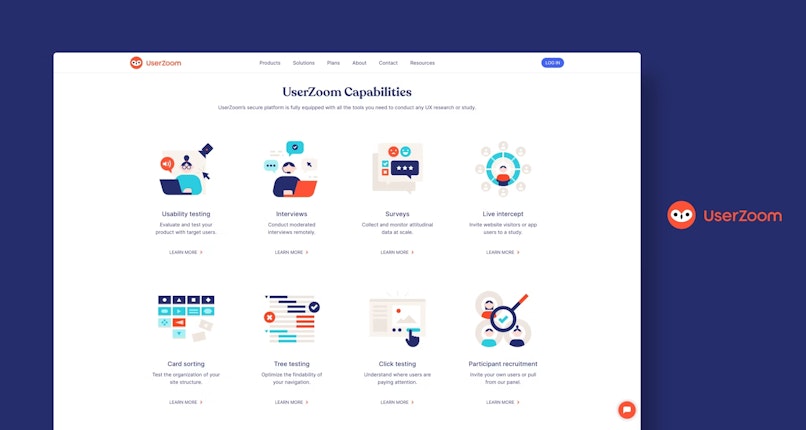
Comprehensive Research Methods: UserZoom combines qualitative and quantitative research methodologies, utilizing AI to offer deep insights into user behaviors, preferences, and pain points.
Data Analysis and Insights: Its AI capabilities extend to advanced data analysis, providing actionable insights that can inform key design decisions. UserZoom's analytics help in understanding user journey bottlenecks and areas for improvement.
Scalable User Testing: The platform facilitates large-scale remote user testing, making it a valuable tool for companies looking to gather extensive user feedback efficiently.
Use Case Study: A leading retail website utilized UserZoom to gain insights into customer browsing behaviors. The AI analysis highlighted non-intuitive navigation paths, prompting a redesign that simplified user flows. This change resulted in a 25% increase in average session duration and a significant boost in sales conversions.
4. Amped Research:
Specializing in automating UX research, Amped Research excels in remote user testing and feedback analysis.
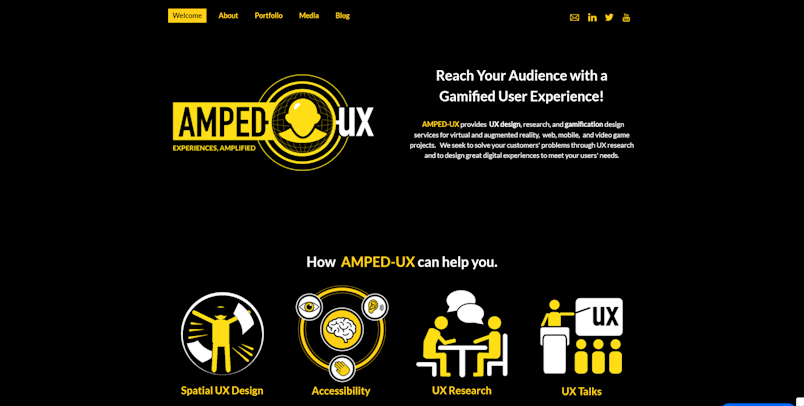
Automated Research Process: Specializing in automating the UX research process, Amped Research is adept at facilitating remote user testing and feedback collection.
Feedback Analysis: The tool's AI algorithms efficiently analyze user feedback, identifying key themes and insights that can guide the iterative design process.
User Interaction Insights: Amped Research provides detailed analyses of user interactions, enabling designers to understand user behavior patterns and optimize user interfaces accordingly.
Use Case Study: A video game developer leveraged Amped Research to gather user feedback on a new game interface. The AI-facilitated analysis of user interactions led to strategic modifications in the game's tutorial and difficulty settings. These changes were critical in enhancing user engagement levels, evidenced by a surge in positive reviews and player retention rates post-launch.
5. Dovetail:
Dovetail employs AI for efficient analysis of qualitative data, aiding researchers in deriving meaningful insights.
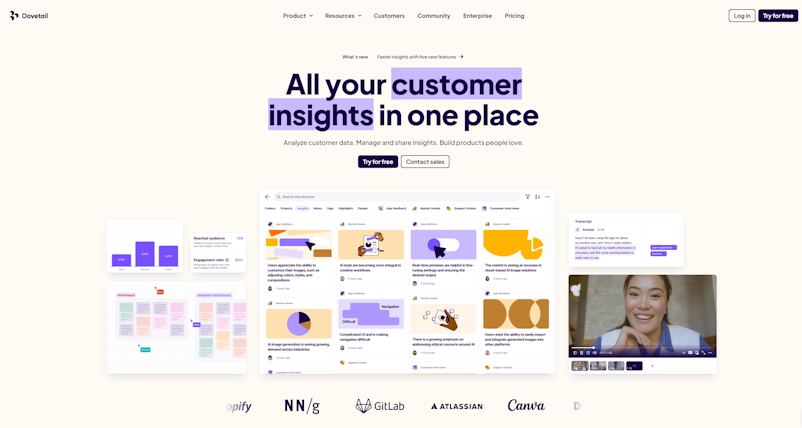
Qualitative Data Analysis: Dovetail excels in analyzing qualitative data, such as user interviews and feedback. Its AI-driven approach helps in extracting meaningful patterns and insights from extensive user data.
Insight Presentation: The platform offers a streamlined way to organize and present research findings, making it easier for UX researchers to communicate insights to stakeholders.
Collaborative Research Environment: Dovetail provides a collaborative environment for research teams to work together, share insights, and make data-driven decisions.
Each of these tools represents a significant advancement in the field of UX research, offering unique capabilities that enhance the efficiency, accuracy, and depth of user experience studies.
Use Case Study: In the healthcare sector, a telemedicine app used Dovetail to analyze patient feedback. The AI-driven insights helped streamline the patient journey within the app, making it more accessible to a broader demographic, including elderly users. This enhancement led to a marked increase in app adoption rates and patient satisfaction scores, highlighting the value of AI in creating inclusive and user-friendly digital health solutions.
Each of these tools represents a significant advancement in the field of UX research, offering unique capabilities that enhance the efficiency, accuracy, and depth of user experience studies.
For more AI-powered UX tools to spark your creativity and take your UX designs to a magical realm, we've compiled a list of AI tools every designer must have.
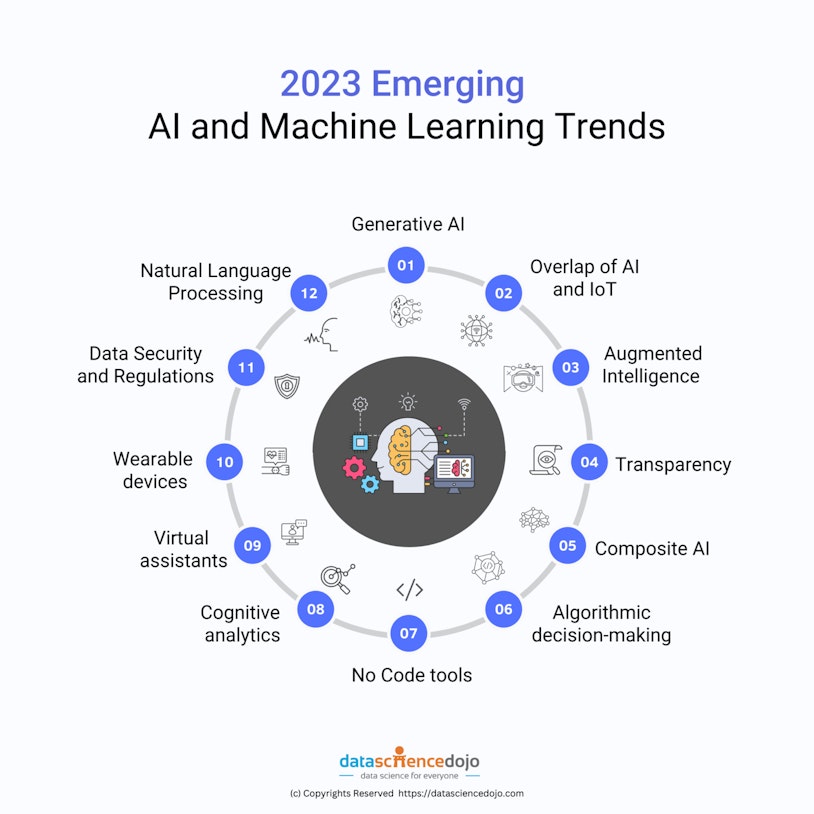
7 Emerging Trends in AI-Driven UX Research
In 2024 and beyond, the world of UX research is being profoundly reshaped by AI, creating a dynamic where traditional methods meet advanced technology. This integration is revolutionizing user experience insights, leading to more innovative and user-focused product development. Here are 7 of the transformative AI trends that will shape the future of UX research.
Continuous Research: This trend emphasizes ongoing, iterative research methodologies. Organizations are shifting towards real-time insights, allowing for rapid adaptability to user feedback and market changes. This approach is crucial in today's fast-paced digital landscape, where user preferences and technological advancements evolve quickly.
Democratization of Research: There's an increasing trend toward making UX research tools and methodologies accessible across different roles within organizations. This democratization fosters a culture of shared understanding of user needs and experiences, enhancing collaborative efforts in product development.
Shifting Roles of UX Researchers: The role of UX researchers is evolving beyond traditional research tasks to more strategic and consultative positions. Researchers are increasingly involved in guiding product strategies, leveraging their deep understanding of user needs to inform critical business decisions.
Emphasis on Inclusive Products: Designing inclusive and accessible products is gaining prominence. There's a focus on creating solutions that cater to a diverse range of users, considering various abilities, backgrounds, and preferences, thus ensuring products and services are usable and beneficial to a broader audience.
Integration of Advanced AI Tools: The use of sophisticated AI technologies is on the rise for deeper data analysis and predictive modeling. These tools are enabling UX researchers to gain enhanced insights into user behavior and preferences, leading to more informed design decisions.
User Empathy and Ethical Considerations: With the integration of AI, there's a growing need to balance technological capabilities with human empathy and ethical considerations. Researchers are tasked with ensuring that AI-driven processes respect user privacy, and consent, and deliver unbiased results.
Collaboration Between AI and Human Expertise: The synergy between AI-driven insights and human creativity is strengthening. This collaboration leverages the precision and efficiency of AI with the intuitive and empathetic understanding of human researchers.
These trends highlight a shift towards more dynamic, inclusive, and technologically advanced UX research practices, significantly impacting how organizations approach product development and user experience design.
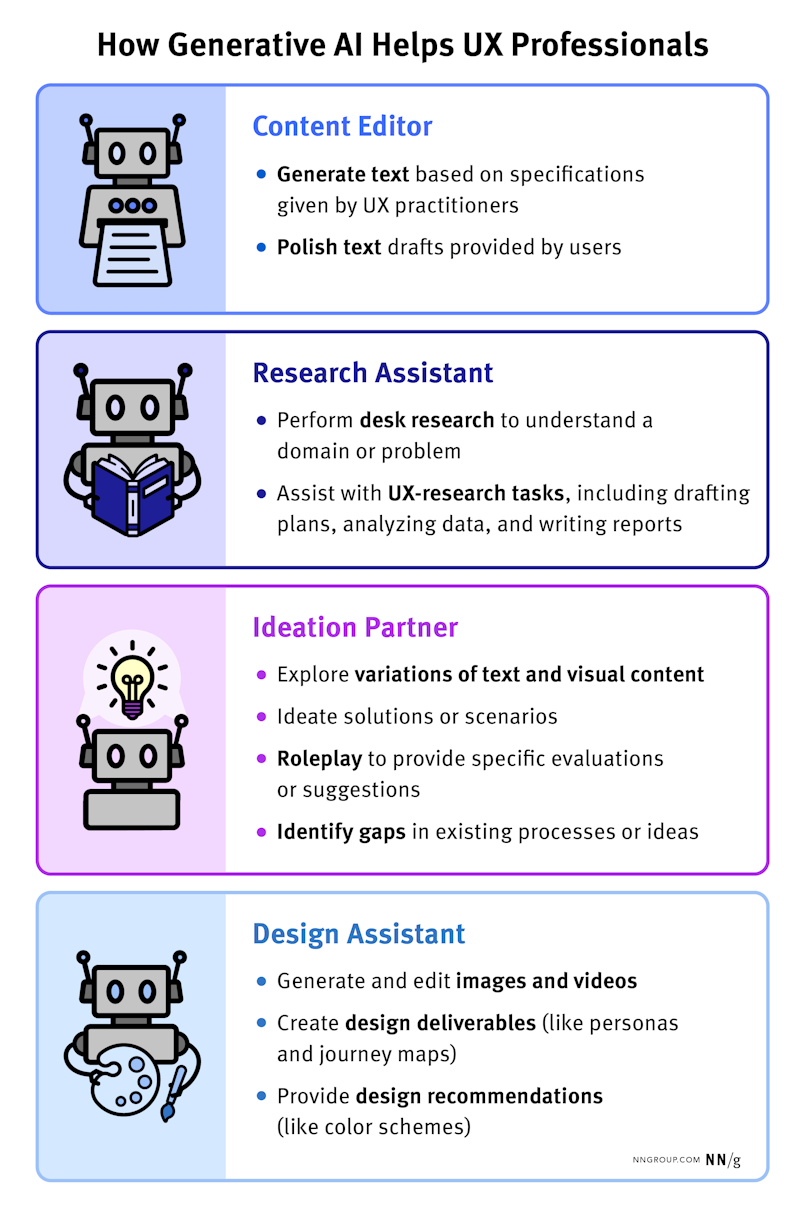
Advantages of Integrating AI in UX Research
Integrating AI into UX research unlocks significant benefits, including accelerated research processes, cost reduction, and improved data consistency. Let’s look at 10 key advantages of AI in UX research and how it’ll enhance the field's overall productivity and innovation.
Faster Research: AI significantly accelerates data analysis and user feedback processing, reducing research cycle times.
Reduced Costs: Automated processes and efficient data handling lower operational costs associated with UX research.
Improved Consistency: AI algorithms ensure uniformity in data analysis, leading to more reliable and repeatable research outcomes.
Ease of Use: User-friendly AI tools simplify complex research tasks, making them accessible to a broader range of professionals.
Increased Research Volume: AI's capability to handle large data sets enables the undertaking of more extensive research projects without proportional increases in time or resources.
Enhanced Precision: AI tools improve the accuracy of data interpretation, leading to more precise research findings.
Real-time Insights: AI enables the gathering and analysis of user data in real-time, providing immediate feedback for quicker decision-making.
Predictive Analysis: AI's ability to predict user behaviors and preferences allows for proactive design adjustments.
Diverse Data Handling: AI can process and analyze data from varied sources, providing a holistic view of user experiences.
Customized User Experience: AI facilitates the creation of personalized user experiences by understanding individual user patterns and preferences.
Each of these benefits illustrates the comprehensive impact of AI on enhancing UX research processes and outcomes, supported by technological advancements and industry expert insights.
5 Challenges and Limitations of AI in UX Research
While AI heralds efficiency and innovation, it also presents notable challenges. Here are 5 of the most common challenges of AI in UX research we’ve identified:
Contextual Misinterpretation: AI's inability to fully comprehend the context and underlying user emotions can lead to misinterpretation of data, affecting the depth and accuracy of research findings.
Empathy Deficit: Essential in UX research, empathy allows for a deeper understanding of user experiences. AI's lack of emotional intelligence means it cannot empathize with user emotions and reactions, potentially missing subtle yet crucial insights.
Flexibility and Creativity Constraints: AI operates within the parameters of its programming and training data. This limits its flexibility in adapting to new, unforeseen scenarios and its capacity for creative problem-solving, which are vital in innovative UX research.
Accuracy and Reliability Issues: AI's effectiveness is contingent on the quality and diversity of its training data. Inaccurate or biased data can lead to unreliable results, making it imperative for researchers to critically evaluate AI-generated insights.
Innovative Limitations: While AI can process and analyze data at remarkable speeds, its dependency on existing data and patterns may restrict its ability to contribute to groundbreaking design solutions.
How to Navigate the Limitations of AI in UX Research
Navigating these many challenges of AI in the process of conducting UX Research involves a synergistic approach:
Leveraging AI for preliminary data analysis while relying on human researchers for deeper contextual and emotional interpretation.
Ensuring diverse and comprehensive training datasets for AI to enhance its understanding and reliability.
Employing AI as an assistant to human creativity, not a replacement, fosters a collaborative environment where both can thrive.
Regular updates and retraining of AI systems to keep up with evolving UX trends and requirements.
Applying a critical lens to AI-generated data, especially when dealing with complex user behaviors or novel design challenges.
In essence, the integration of AI in UX research demands a balanced approach, combining the best of both AI capabilities and human expertise.

Best Practices and Ethical Considerations in AI-Driven UX Research
Responsibly integrating AI in UX research involves adhering to 10 best practices and ethical considerations:
Transparency: Clearly communicate how AI is used in research processes, including data collection and analysis methods.
Data Privacy and Consent: Ensure user data is collected with informed consent, maintaining strict confidentiality and privacy standards.
Bias Mitigation: Actively work to identify and reduce biases in AI algorithms, ensuring diverse and representative training datasets.
Human Oversight: Maintain human involvement in AI-driven research to interpret data within context, providing nuance that AI might miss.
Ethical AI Use: Employ AI ethically, avoiding manipulative practices and respecting user autonomy and dignity.
Continual Learning and Adaptation: Regularly update AI systems with new data and insights to keep pace with changing user behaviors and trends.
Collaboration and Interdisciplinary Approach: Foster collaboration between AI experts, UX researchers, and ethicists to address complex ethical challenges.
Sustainability: Consider the environmental impact of AI and strive for sustainable practices in research methodologies.
Inclusivity and Accessibility: Design AI-driven UX research tools and processes to be inclusive and accessible to diverse user groups.
Accountability: Establish clear lines of accountability for decisions made based on AI-generated insights, ensuring responsible and ethical application.
Adhering to these principles ensures that AI in UX research not only advances innovation but also respects and upholds ethical standards and human values.
Case Studies: Industry-Specific Impacts
Retail: AI-Powered Personalization for E-commerce
The retail industry has witnessed a significant transformation due to the integration of AI technologies. One good example is the use of AI to optimize e-commerce platforms for personalized user experiences. AI algorithms can identify individual preferences, browsing history, and purchase patterns by analyzing vast amounts of customer data.
This enables retailers to:
Tailored Product Recommendations
Dynamic Pricing Strategies
Personalized Marketing Campaigns
Healthcare: Enhancing Telemedicine with AI
AI has played a crucial role in enhancing the accessibility and user experience of telemedicine apps, particularly benefiting diverse patient demographics. For more on how AI is impacting healthcare, read this detailed article on AI healthcare startups. Here are some key applications:
AI-Powered Symptom Checkers:
Virtual Assistants for Patient Support
Remote Patient Monitoring
AI helps health startups to offer more efficient and personalized healthcare services, bridging geographical and socioeconomic gaps in access to care.
Integrating AI into the UX Workflow
AI has changed the UX research process, simplifying workflows and delivering more insightful results. Here's a breakdown of how you can integrate AI into each research stage of the UX process:
1. Discovery
At this point, your goal should be generating quality user insights to fuel your designs.
Persona Creation: Use tools like ChatGPT to analyze large datasets of user behavior, demographics, and psychographics to automatically generate detailed user personas.
Trend Analysis: Use Sprout Social to efficiently scan and analyze vast amounts of online content, social media, and industry reports to identify emerging trends and potential opportunities.
2. Design & Testing
Your research in this stage should be focused on improving your designs based on real user feedback.
A/B Testing: AI-driven A/B testing platforms like Hotjar can automate the process of creating and deploying variations, analyzing results, and optimizing designs based on data-driven insights.
Prototyping: Use UX Pilot for generating design concepts, layout improvements, and even automating the creation of low-fidelity prototypes.
Usability Testing: AI tools like Maze analyze user behavior during testing sessions, identifying pain points, areas for improvement, and potential usability issues.
3. Post-Launch
Research doesn't end at launch. To make sure your product consistently stays useful and usable, more research is needed.
Real-time Data Analysis: Use AI-powered analytics tools to continuously monitor user behavior, track key metrics, and identify trends. This enables UX teams to make data-driven decisions and optimize the product experience in real-time.
Predictive Analytics: AI algorithms can predict user behavior, anticipate future needs, and recommend personalized experiences. This helps in proactive product refinement and innovation.
AI's Role in Enhancing Cross-Disciplinary Collaboration
AI is also improving how UX researchers collaborate with designers, developers, and product managers. These tools promote a more effective and efficient workflow. Here's how:
Real-Time Insights
Informed Decision-Making: AI-powered tools generate real-time data on user behavior, preferences, and feedback. This enables teams to make quick, informed decisions based on the latest insights.
Iterative Design: By providing immediate feedback on design iterations, AI helps teams to rapidly iterate and improve their designs.
Data-Driven Communication
Visualizing Complex Data: AI can visualize complex research data in easy-to-understand formats, such as heat maps, user flows, and sentiment analysis. This makes it easier for non-technical stakeholders to grasp key insights.
Bridging the Gap: AI bridges the gap between technical and non-technical team members by providing a common language for discussing user research and design.
Seamless Collaboration
Collaborative Platforms: AI-powered collaborative platforms facilitate real-time communication, sharing of work, and feedback across teams.
Automated Workflows: AI can automate routine tasks, such as generating reports, conducting user tests, and deploying updates. This frees up team members to focus on higher-level tasks and collaboration.
With AI, teams can break down silos, promote a culture of collaboration, and ultimately deliver better user experiences.
Scaling UX Research with AI in Large Organizations
Large organizations often struggle to scale their UX research efforts due to the sheer volume of data and the complexity of managing diverse user groups. AI can help address these challenges by providing efficient and scalable solutions.
Handling Large Data Sets
AI-powered data analysis tools can automate the process of collecting, cleaning, and organizing large datasets, freeing up researchers to focus on analysis and interpretation. Advanced AI algorithms can quickly analyze vast amounts of data, identifying patterns, trends, and anomalies that would be difficult to spot manually.
Global User Testing
AI-powered translation tools can facilitate user testing with participants from diverse linguistic backgrounds. Additionally, AI can help researchers understand cultural nuances and tailor their research methods accordingly.
Automation of Repetitive Tasks
AI is good at automating data entry tasks, such as transcribing interviews or coding surveys. AI-powered tools can also perform basic analysis tasks, such as sentiment analysis and topic modeling.
AI-Enabled Reporting
AI can generate detailed reports, including visualizations and insights, based on the analyzed data. Furthermore, AI can tailor reports to specific audiences, such as executives, product managers, or designers.
Large organizations will find it easier to scale their UX research efforts, gain deeper insights into user behavior, and make data-driven decisions that improve the user experience simply by leveraging AI.
The Future of AI in UX Research
Without any doubt, what lies ahead for AI within UX research is revolutionary changes. AI's capability to tailor user experiences will be more advanced and result in highly customized user interfaces that are based on the individual's habits and preferences.
Data-driven decision-making, aided by AI will greatly improve the accuracy and quality of UX research, allowing researchers and experts to design more educated and precise predictions of user requirements and trends. This will result in user-friendly designs that are intuitive and user-centric, constantly evolving thanks to AI's algorithms for learning.
The use of AI in UX research isn't just about technological advancement, it's about changing how we perceive as well as interact with the users. It forces professionals to consider the effects of AI's use in the field of design and research. As we enter this new technological age it's crucial to consider how AI can be used responsibly to improve user experiences while maintaining ethical guidelines.
Conclusion
In conclusion, AI's introduction into UX research is a sign of an era of new technological advancement and accuracy. From increasing the speed of research to improving data accuracy, and providing customized user experiences AI will revolutionize the field.
As we take on these new developments UX professionals must think about the ethical implications and continue to maintain the human-centric approach. Think about how you can integrate AI in your UX research methods, and embrace its potential, while also navigating the obstacles with care.






